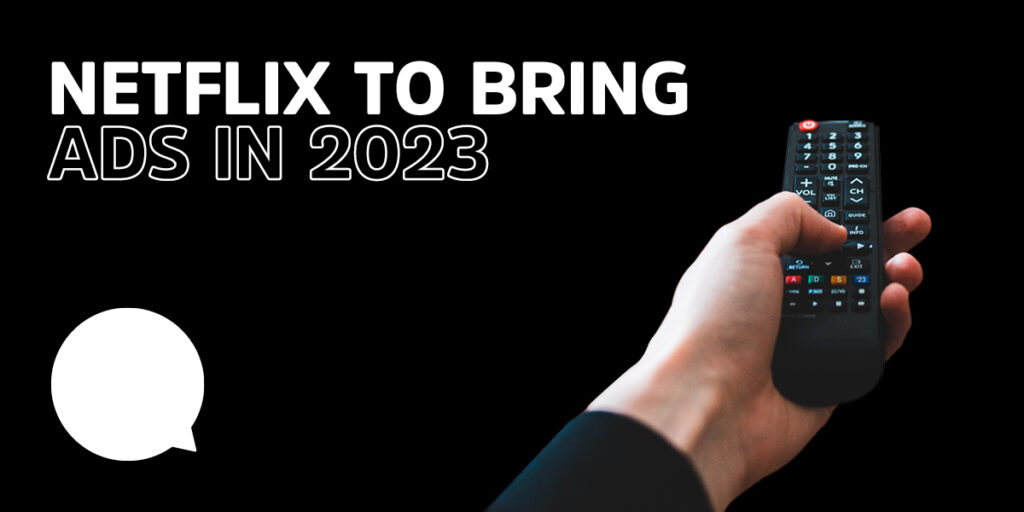Netflix Adverts are Coming: Outrage or Opportunity?
22nd September 2022
Some say it was inevitable, others thought it would never happen, but it’s now confirmed – Netflix will show adverts before some films and TV shows.
In a recent announcement, the global streaming service has decided that a new plan that includes adverts is the answer to their current growth problem. And as of 1 November, users in territories like France, Australia, Canada and US will be able to choose a lower-priced subscription option. If the new subscription plan is successful, then we can expect a global roll-out, and a cheaper Netflix package in the UK.

However, this doesn’t mean you’ll suddenly be bombarded by irrelevant adverts, or that your movie will be paused halfway through for a YouTube-style skippable advert.
Netflix has promised that the usual subscription options won’t contain ads (apart from the already-existing clips for other Netflix shows and movies that sometimes pop up), and that the ad-inclusive version is designed for potential customers who feel Netflix is expensive, and don’t mind watching adverts if this means the cost is lower.
The usual advert anger
Despite Netflix adverts being totally optional, the usual outrage has resounded around the internet.
But let’s be honest, advertising to captive audiences is nothing new. Take the cinema. The adverts, usually for other movies, but sometimes for an innocuous product, are all part of the experience, an experience many of us have had from birth.
Also, look at Sky TV. You pay a premium for access to Sky’s sports, movie and TV services, and you’ll spend a good 10-15% of your time watching adverts during ‘accepted’ commercial breaks.
And YouTube? We’re happy to wait five seconds, or even pay for the premium YouTube service to get around having to watch adverts.
So, despite being nothing new, controversy reigns supreme as, shock horror, a commercial enterprise looks at ways of increasing revenue and trying to keep hold of a subscriber base that has plummeted in recent months as services like Disney+, HBO Max and Paramount+ have gained market share.
The big picture
Rather than outrage at something we accept elsewhere, the real talking point should be how brands like Netflix, who have long dismissed the premise of advertising on the service, are changing tact as our tolerance for advertising grows.
Social media platforms, who often have ads built-in from inception date, have made adverts so accepted and ubiquitous that it’s all part of the experience. Add in the fact that following brands you like or spending time looking at their content means the adverts you’ll see are more likely to be tailored to your preferences.
And as the next generation of Netflix subscribers pays their £6 or so for the ad-based service, their acceptance for adverts from day one won’t have any impact on their enjoyment of the service – it just becomes part of the deal.
But which other digital services could jump on advertising, and is this a big opportunity for brands?
Tapping into new audiences
Netflix’s new advertising structure is being delivered by Microsoft. It’s anticipated that big brands will initially show non-tailored ads, before more detailed data is fed into user accounts to ensure relevant ads are shown as the service develops.
For advertisers, Netflix’s global name and the potential for millions of new ad-watching customers will certainly make waves.
But what about other digital services, with usership in the millions, who may look to in-app or in-experience advertising to boost revenue or offer a low-cost subscription model?
Imagine, say, your Booking.com app (3 million downloads in Q1 2022) decided to show third-party adverts in search results or on booking pages? Or if your favourite fitness tracking app threw up a few videos here and there for relevant products when you go to check your step count?
It’s already kind of happening, especially in mobile games and on our social media platforms, but it’s not as prevalent for major brands who have for a long time defended their hard-earned traffic. But if the user is going to click off to an advert, or pause their Netflix show to Google something that’s piqued their interest anyway, then surely the revenue from that action outweighs an uninterested audience that is growing bored of Netflix’s current offering?
As our behaviours towards ads change, so must the way they are presented to us – and here lies the challenge for brands who want to leverage other people’s audiences, and pay a premium for the pleasure.
Need help with your advertising efforts? Get in touch with us today.

